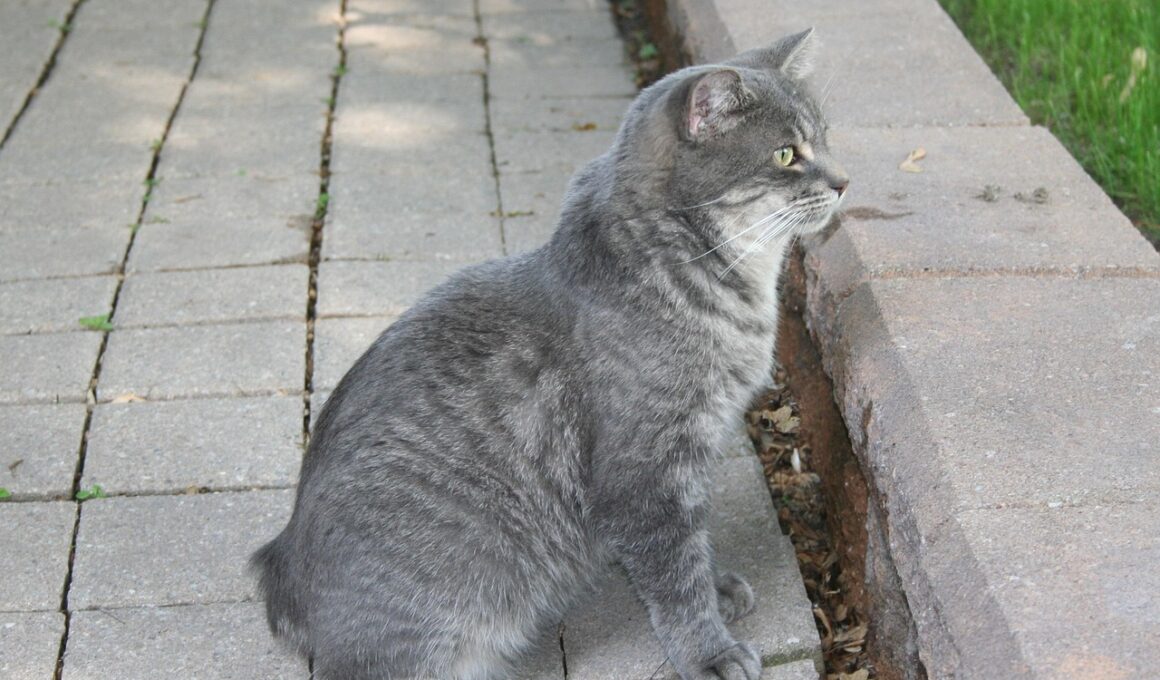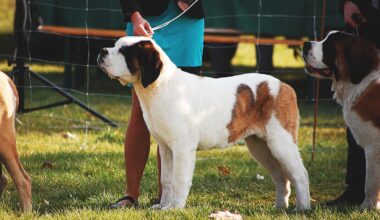The Genetics Behind the Manx Tail Mutation
The Manx cat, a peculiar breed known for its distinctive tail mutation, has intrigued geneticists and cat lovers alike. This breed’s most notable feature is the absence of a tail or its very short length. This mutation is primarily attributed to a dominant allele, known as the “Manx allele.” Understanding this genetic background can provide insight into how such traits are inherited in feline genetics. The mutation prevents the formation of the vertebrae at the base of the tail during the development of the embryo, leading to various tail lengths ranging from none to a short bob. Besides having a unique tail, the Manx is known for its round face, large ears, and captivating personality. Their playful nature, intelligence, and friendliness make them a cherished companion. Despite their charm, potential owners should be aware of the genetic issues that may arise, including spinal problems. This breed’s genetics provide a remarkable example of how a single gene can significantly influence an animal’s structure and behaviors, displaying how broader genetic principles apply not only to cats but to a range of other species.
Genetic Variation in Manx Cats
The genetics of the Manx breed reveal a fascinating interplay between dominant and recessive traits. The Manx gene affects not only tail length but can also lead to variations in overall body structure. When bred, a typical Manx to a non-Manx may yield a diverse range of offspring, showcasing differing tail lengths due to the variation in gene expression. This variation means that while the dominant allele provides specific characteristics, recessive traits can also appear depending on genetic combinations. Experimental breeding has shown that the presence or absence of a tail can influence other aspects, such as temperament and health. Some researchers have found correlations between the tail length and susceptibility to certain health concerns, particularly spinal deformities. Thus, breeders must navigate these complexities while prioritizing health and well-being. Ethical breeding practices should always consider the potential for genetic abnormalities. It is essential that prospective owners research various genetic traits and their implications before choosing to adopt a Manx cat. Understanding genetics can enhance the experiences of owning this unique breed, leading to more informed decisions.
One of the most important factors impacting the health of Manx cats is linked to their genetic makeup. A significant concern is the presence of spina bifida, a neural tube defect related to the Manx mutation. This condition, while not visible externally, poses serious risks to the animal’s health and well-being. Breeders must therefore conduct thorough health screenings and genetic testing to minimize the risks associated with breeding practices. The Manx mutation can sometimes lead to colonic issues as well, as the absence of an appropriate tail may affect how stool is expelled. These health concerns should always be discussed with potential pet owners, ensuring they have realistic expectations regarding the care and maintenance of a Manx cat. With proper genetics education, issues can be identified early, allowing for better management. As awareness grows in the breeding community, enthusiasm for responsible practices should increase, promoting the well-being of the breed. Ultimately, knowledge can empower both breeders and owners alike, fostering healthier generations of Manx cats without compromising their unique characteristics, ultimately preserving the integrity of this charming breed.
Behavioral Traits Linked to Genetics
The behavioral traits of the Manx catstem from their genetics as much as their physical attributes. Typically, they are playful, active, and exceptionally affectionate. These traits may be influenced by their unique genetic composition, which ties back to their history and pedigree. Many Manx cats exhibit strong bonds with their families, displaying loyalty and intelligence. They are often described as curious and friendly, making them ideal pets for families and individuals. Socialization is essential for this breed, particularly in their younger years, to develop confident and well-rounded personalities. Owners often notice that Manx cats enjoy interactive play, often displaying hunting instincts. This playful tendency could be linked to their natural drive for exploration and challenge. Owners should strive to engage their pets mentally and physically through toys and activities that stimulate their natural instincts. Proper stimulation can help prevent behavioral issues, ensuring a thriving environment for their beloved pets. Enhancing the relationship between humans and Manx cats can also foster better behavior overall. By understanding their genetics, owners can tailor their care to meet their emotional and physical needs.
The iconic appearance of the Manx breed, characterized by its round shape and dense coat, is equally shaped by genetics. The gene responsible for the tail mutation also impacts body structure, leading to a robust and muscular physique. Unlike many cats, a well-cared-for Manx cat is often perceived as a hefty, well-rounded companion. The degree of robustness can depend on the genetic background of the individual cat, influenced by parents with strong traits themselves. While they possess a dynamic energy level, which contributes to their playful reputation, they also exhibit a tendency towards a more relaxed disposition. Their unique musculature allows them to reach impressive speeds, especially when engaging in play. Moreover, their coat can come in a variety of colors and patterns, showcasing the genetic diversity within this breed. This colorful spectrum is part of what makes Manx cats so attractive to enthusiasts and breeders. Understanding the connection between genetics and physical attributes can enhance appreciation for this wonderful breed, ensuring that future generations of Manx cats carry these rich traits forward into the breeding community.
Challenges Faced in Breeding
Breeding Manx cats presents numerous challenges tied closely to their genetic anomalies. The risk of passing on undesirable genetic traits is heightened due to the breed’s unique allele. This situation places considerable responsibility on breeders to educate themselves on the complexities of their reproductive choices. Developing a successful breeding program requires not only attention to the integrity of the gene pool but also a solid understanding of genetic testing. Prospective breeders are encouraged to conduct thorough evaluations of their breeding stock to minimize health issues associated with the Manx allele. Additionally, ethical breeders are tasked with disseminating knowledge on best practices with fellow breeders and pet owners alike. It’s vital that breeding not only aims for aesthetic qualities but also prioritizes the health and happiness of the cats involved. Potential breeding pairs should be thoroughly screened to identify possible health issues before any breeding occurs. This conscientious approach to breeding practices has significant implications for the future sustainability of the Manx breed, ensuring genetic diversity and healthy cat populations for years to come.
Lastly, the future of the Manx breed hinges on effective awareness of genetics within the cat community. As the understanding of genetics advances, it opens up new possibilities for healthier breeding practices and mitigating health risks. Both breeders and owners play essential roles in this process, advocating for responsible breeding methods and informed choices. Education initiatives can provide crucial information surrounding the specific needs and health considerations for prospective owners. Additionally, engaging in community forums, workshops, and seminars can help disseminate valuable resources. By tapping into these modern developments, breeders can ensure that they are choosing the best paths forward for their programs. Future-focused breeding will not only honor the unique traits of the Manx cat but will also prioritize its long-term health. Ultimately, a concerted effort from all parties involved signifies a commitment to preserving the breed for generations to come while remaining conscientious about the inherent challenges. This collective goal emphasizes the importance of genetics in shaping the future of the Manx breed, establishing a legacy of resilience and integrity that serves as an inspiration.
Conclusion
By engaging with these genetic principles, understanding the importance of ethical breeding practices is essential. Manx cats embody a unique blend of charm, intelligence, and physical prowess rooted in their genetics. They have captured the hearts of many across the world, but the ongoing focus must be placed on health and well-being as priorities for this beloved breed. As communities continue to foster responsible narratives around breeding, we can ensure the longevity and welfare of Manx cats into the foreseeable future. The relationship between genetics and behavior is complex and intertwined, allowing for deeper insight into what makes these cats truly special. Responsible management of breeding programs can lead to healthier generations and more mindful choices for prospective owners. Enhancing the overall understanding of genetics in this beloved breed not only supports ethical considerations but galvanizes a growing movement for sustainable breeding practices. Owners and breeders alike can take significant pride in their roles, nurturing the Manx legacy while placing an emphasis on health and care. Ultimately, the future of the Manx cat depends on informed choices, collaborative efforts, and a dedicated commitment to improving the lives of these fascinating felines.


